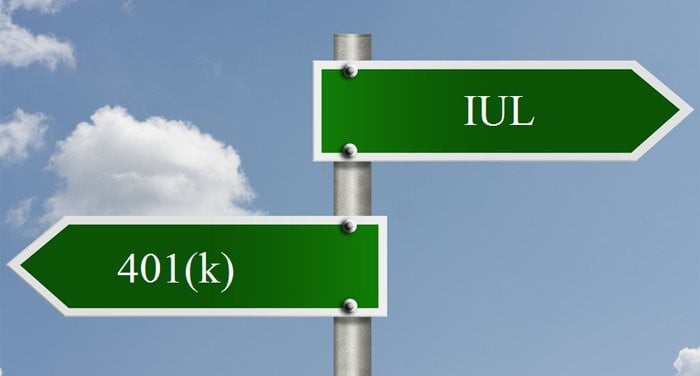When it comes to planning for retirement, the 401(k) has long been the go-to option for many. However, there’s a new contender in town that’s gaining traction: Indexed Universal Life Insurance (IUL). This innovative financial product is not just about providing life insurance coverage; it also offers a unique blend of investment opportunities and tax advantages that could make it a compelling alternative to the traditional 401(k). In this article, we’ll explore why IUL might be the new 401(k), delving into its features, benefits, and potential drawbacks. Whether you’re a seasoned investor or just starting to think about your financial future, understanding the ins and outs of IUL could open up new possibilities for your retirement planning.
Introduction to Indexed Universal Life Insurance (IUL)

Indexed Universal Life Insurance (IUL) is a type of permanent life insurance that not only provides a death benefit to your beneficiaries but also includes a cash value component that can grow over time. What sets IUL apart from other life insurance policies is its unique investment feature: the cash value growth is linked to the performance of a stock market index, such as the S&P 500. This means that while your cash value has the potential to grow based on market performance, it also comes with a level of protection against market downturns, as it typically includes a guaranteed minimum interest rate.
IUL policies offer flexibility in premium payments and death benefits, allowing policyholders to adjust their contributions and coverage as their financial needs change. Additionally, the tax advantages associated with IUL, such as tax-deferred growth and tax-free loans against the policy’s cash value, make it an attractive option for those looking to build wealth and secure their financial future.
How IUL Works
When a policyholder pays premiums into an IUL policy, a portion of the premium goes towards the cost of insurance and policy fees, while the remainder is credited to the policy’s cash value. The cash value grows based on the interest credited, which is linked to the performance of a specified index. However, the policyholder does not participate directly in the stock market, thus avoiding direct market risks.
The combination of life insurance protection and potential cash value growth makes IUL an attractive option for individuals looking for both security and the opportunity for higher returns. It offers a unique way to accumulate wealth over time while providing a safety net for loved ones.
Understanding 401(k) Plans

A 401(k) plan is a popular retirement savings option offered by many employers in the United States. Named after the section of the Internal Revenue Code that established it, a 401(k) allows employees to save and invest a portion of their paycheck before taxes are taken out. This means that contributions to a 401(k) are made with pre-tax dollars, reducing the employee’s taxable income for the year.
One of the key features of a 401(k) plan is the potential for employer matching contributions. Many employers will match a portion of the employee’s contributions, effectively providing “free money” to help boost retirement savings. The contributions and any investment gains in a 401(k) grow tax-deferred, meaning that taxes are not paid until the money is withdrawn, typically during retirement.
401(k) plans offer a variety of investment options, including mutual funds, stocks, bonds, and other securities. Employees can choose how to allocate their contributions among these options based on their risk tolerance and retirement goals. However, there are annual contribution limits set by the IRS, and early withdrawals before the age of 59½ may be subject to penalties and taxes.
While 401(k) plans offer significant tax advantages and the potential for employer matching, they also come with some limitations. For example, the investment options may be limited to those offered by the plan provider, and there are required minimum distributions (RMDs) that must begin at age 72. Additionally, the performance of the investments is subject to market fluctuations, which can impact the overall growth of retirement savings.
Understanding the benefits and limitations of 401(k) plans is crucial for making informed decisions about retirement savings. By comparing 401(k) plans with other options, such as Indexed Universal Life Insurance (IUL), individuals can determine the best strategy to achieve their financial goals and secure a comfortable retirement.
Why IUL Might Be the New 401(k)
Indexed Universal Life Insurance (IUL) is gaining attention as a potential alternative to the traditional 401(k) for several compelling reasons. One of the primary advantages of IUL is its tax benefits. Like a 401(k), the cash value growth in an IUL policy is tax-deferred, meaning you won’t pay taxes on the gains until you withdraw the money. However, IUL policies also allow for tax-free loans against the policy’s cash value, providing a source of tax-free income during retirement.
Another significant advantage of IUL is its flexibility. Unlike a 401(k), which has strict contribution limits and penalties for early withdrawals, IUL policies offer flexible premium payments and adjustable death benefits. This means you can tailor your contributions and coverage to match your changing financial needs and goals.
The growth potential of IUL is another factor that makes it an attractive alternative to a 401(k). The cash value in an IUL policy is linked to the performance of a stock market index, such as the S&P 500. This means that your cash value has the potential to grow based on market performance, while also providing a level of protection against market downturns with a guaranteed minimum interest rate. This combination of growth potential and downside protection can make IUL a valuable addition to your retirement planning strategy.
Additionally, IUL policies offer death benefits that can provide financial security for your loved ones. While a 401(k) is primarily focused on retirement savings, an IUL policy combines the benefits of life insurance with the potential for cash value growth, offering a more comprehensive financial solution.
In summary, the tax advantages, flexibility, growth potential, and death benefits of IUL make it a compelling alternative to the traditional 401(k). By understanding these features, you can make informed decisions about your retirement planning and explore new possibilities for securing your financial future.
Pros and Cons of IUL
There are many benefits and potential drawbacks of investing in IUL;
Pros:
- Tax-Deferred Growth: The cash value in an IUL policy grows tax-deferred, meaning you won’t pay taxes on the gains until you withdraw the money. This can help your savings grow more efficiently over time.
- Tax-Free Loans: You can take out loans against the policy’s cash value without paying taxes, providing a source of tax-free income during retirement.
- Flexibility: IUL policies offer flexible premium payments and adjustable death benefits, allowing you to tailor your contributions and coverage to match your changing financial needs and goals.
- Growth Potential: The cash value in an IUL policy is linked to the performance of a stock market index, such as the S&P 500. This means your cash value has the potential to grow based on market performance, while also providing a level of protection against market downturns with a guaranteed minimum interest rate.
- Death Benefits: IUL policies provide a death benefit to your beneficiaries, offering financial security for your loved ones in addition to the potential for cash value growth.
Cons:
- Fees and Charges: IUL policies can come with various fees and charges, including administrative fees, cost of insurance charges, and surrender charges. These can reduce the overall returns on your investment.
- Complexity: IUL policies can be complex and difficult to understand, especially compared to more straightforward investment options like a 401(k). It’s important to fully understand the terms and conditions before purchasing a policy.
- Market Risk: While IUL policies offer a level of protection against market downturns, the cash value growth is still linked to the performance of a stock market index. This means there is some level of investment risk involved.
- Potential for Lower Returns: In certain market conditions, the returns on an IUL policy may be lower than those of other investment options. It’s important to consider your risk tolerance and investment goals when evaluating an IUL policy.
- Premium Requirements: To keep the policy in force and maintain the death benefit, you must continue to pay premiums. If you fail to pay the required premiums, the policy could lapse, and you could lose both the death benefit and the cash value.
By weighing these pros and cons, you can better understand whether an Indexed Universal Life Insurance policy is the right choice for your financial planning and retirement goals.
Comparing IUL and 401(k)

When it comes to retirement planning, both Indexed Universal Life Insurance (IUL) and 401(k) plans offer unique benefits and considerations. Here’s a detailed comparison to help you understand the key differences and similarities between these two options:
1. Investment Options
- IUL: The cash value in an IUL policy is linked to the performance of a stock market index, such as the S&P 500. This provides the potential for growth based on market performance, with a guaranteed minimum interest rate to protect against market downturns.
- 401(k): A 401(k) plan offers a variety of investment options, including mutual funds, stocks, bonds, and other securities. Employees can choose how to allocate their contributions based on their risk tolerance and retirement goals.
2. Tax Advantages
- IUL: The cash value growth in an IUL policy is tax-deferred, and policyholders can take tax-free loans against the cash value. This provides a source of tax-free income during retirement.
- 401(k): Contributions to a 401(k) are made with pre-tax dollars, reducing taxable income for the year. The contributions and any investment gains grow tax-deferred, with taxes paid upon withdrawal.
3. Flexibility
- IUL: IUL policies offer flexible premium payments and adjustable death benefits, allowing policyholders to tailor their contributions and coverage to match their changing financial needs and goals.
- 401(k): 401(k) plans have strict contribution limits set by the IRS, and early withdrawals before the age of 59½ may be subject to penalties and taxes. However, some plans offer loan provisions and hardship withdrawals under specific circumstances.
4. Risk and Reward
- IUL: The cash value growth in an IUL policy is linked to market performance, providing the potential for higher returns. However, there is some level of investment risk involved, although the guaranteed minimum interest rate offers a level of protection.
- 401(k): The performance of a 401(k) plan’s investments is subject to market fluctuations, which can impact the overall growth of retirement savings. The risk and reward profile depends on the chosen investment options.
5. Death Benefits
- IUL: IUL policies provide a death benefit to beneficiaries, offering financial security for loved ones in addition to the potential for cash value growth.
- 401(k): A 401(k) plan does not include a death benefit. However, the account balance can be passed on to beneficiaries upon the account holder’s death.
6. Suitability
- IUL: IUL may be suitable for individuals looking for a combination of life insurance coverage and investment growth, with the added benefit of tax-free loans and flexible premiums.
- 401(k): A 401(k) plan is ideal for employees looking to save for retirement with the potential for employer matching contributions and tax-deferred growth.
By comparing these key aspects, you can better understand which option aligns with your financial goals and retirement planning needs. Both IUL and 401(k) plans have their own advantages and limitations, so it’s important to consider your individual circumstances and consult with a financial advisor to make an informed decision.
Practical Tips for Choosing Between IUL and 401(k)
Choosing between Indexed Universal Life Insurance (IUL) and a 401(k) plan for your retirement savings can be a complex decision. Here are some practical tips to help you make an informed choice:
1. Assess Your Financial Goals:
- Short-Term vs. Long-Term: Determine whether your primary focus is on short-term financial flexibility or long-term retirement savings. IUL offers flexibility in premium payments and access to cash value, while a 401(k) is designed for long-term retirement savings with potential employer matching contributions.
- Risk Tolerance: Consider your risk tolerance. If you prefer a guaranteed minimum interest rate with potential for market-linked growth, IUL might be suitable. If you’re comfortable with market fluctuations and a variety of investment options, a 401(k) could be a better fit.
2. Evaluate Tax Benefits:
- Tax-Deferred Growth: Both IUL and 401(k) offer tax-deferred growth, but IUL also provides tax-free loans against the cash value. Consider how these tax advantages align with your financial strategy.
- Tax Impact on Withdrawals: Understand the tax implications of withdrawals. IUL allows for tax-free loans, while 401(k) withdrawals are taxed as ordinary income.
3. Consider Flexibility and Accessibility:
- Premium Payments: IUL policies offer flexible premium payments, allowing you to adjust contributions based on your financial situation. In contrast, 401(k) plans have strict contribution limits and penalties for early withdrawals.
- Access to Funds: IUL provides access to cash value through loans, offering liquidity if needed. 401(k) plans may offer loan provisions, but early withdrawals can incur penalties and taxes.
4. Analyze Investment Options:
- Market-Linked Growth: IUL’s cash value growth is linked to a stock market index, providing potential for higher returns with some level of protection. 401(k) plans offer a variety of investment options, allowing you to diversify your portfolio based on your risk tolerance.
- Investment Control: Consider how much control you want over your investments. IUL policies have limited investment options tied to market indices, while 401(k) plans offer a broader range of choices.
5. Consult with Financial Advisors:
- Professional Guidance: Seek advice from financial advisors who can provide personalized recommendations based on your financial goals, risk tolerance, and retirement planning needs.
- Comparative Analysis: A financial advisor can help you compare the potential outcomes of IUL and 401(k) investments, taking into account your unique circumstances.
6. Review Policy and Plan Details:
- Understand Fees and Charges: Be aware of the fees and charges associated with IUL policies, such as administrative fees and cost of insurance charges. Similarly, review the fees and expenses of your 401(k) plan.
- Policy Terms and Conditions: Carefully read the terms and conditions of both IUL policies and 401(k) plans to ensure you fully understand the benefits, limitations, and requirements.
By considering these practical tips, you can make a well-informed decision about whether Indexed Universal Life Insurance or a 401(k) plan is the best fit for your retirement savings strategy. Remember, it’s important to align your choice with your financial goals, risk tolerance, and overall retirement planning needs.
FAQs
Q 1. What is the minimum premium required for an IUL policy?
Ans. The minimum premium for an IUL policy varies depending on the insurance provider and the specific policy. Generally, it can range from a few hundred to several thousand dollars annually.
Q 2. Can IUL policies be customized to fit individual needs?
Ans. Yes, IUL policies are highly customizable. You can adjust premium payments, death benefits, and the allocation of the cash value to different index options. This flexibility allows you to tailor the policy to your financial goals and changing circumstances.
Q 3. How does the cash value in an IUL policy grow?
Ans. The cash value in an IUL policy grows based on the performance of a selected market index, such as the S&P 500. However, the cash value is not directly invested in the market. Instead, it earns interest based on the index’s performance, subject to caps (maximum limits) and floors (minimum guarantees) set by the insurance company.
Q 4. Are there any penalties for early withdrawals from an IUL policy?
Ans. Yes, early withdrawals from an IUL policy can incur penalties, especially if taken within the first few years of the policy. Additionally, withdrawals can reduce the death benefit and the cash value. It’s important to review the policy terms and consult with your insurance provider before making withdrawals.
Q 5. Can I take loans against the cash value of my IUL policy?
Ans. Yes, you can take loans against the cash value of your IUL policy. These loans are typically tax-free and can be used for various purposes. However, unpaid loans and interest can reduce the death benefit and the cash value. It’s important to manage loans carefully to avoid negatively impacting the policy.
Q 6. Who should consider an IUL policy over a 401(k)?
Ans. Individuals who need life insurance coverage and are looking for a tax-advantaged way to grow their savings might consider an IUL policy. It can be particularly beneficial for those who have maxed out their 401(k) contributions or are seeking additional retirement planning options with more flexibility.
Conclusion
Indexed Universal Life Insurance (IUL) and 401(k) plans each offer unique benefits and drawbacks, making the choice between them highly dependent on individual financial goals and circumstances. IUL provides the dual advantage of life insurance coverage and investment growth with tax-free benefits and market participation with downside protection. On the other hand, 401(k) plans are well-established retirement savings vehicles with tax-deferred growth and potential employer matching.
When deciding between an IUL and a 401(k), it’s crucial to consider factors such as your retirement goals, tax implications, investment flexibility, fees, and accessibility. Consulting with a financial advisor can also provide valuable personalized insights to help you make the best decision for your financial future.
Ultimately, whether IUL might be the new 401(k) for you depends on your specific needs and financial strategy. By understanding the pros and cons of each option, you can make an informed choice that aligns with your long-term financial goals.

Shubham is a passionate insurance expert with years of experience in the industry. I write about home, auto, travel, life, and health insurance to help readers make informed decisions. My goal is to break down the details of coverage, costs, and claims in a straightforward, easy-to-understand way, so you can protect what matters most without the confusion.


